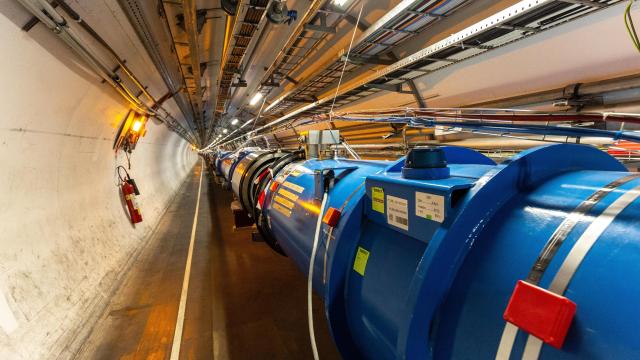CERN’s Large Hadron Collider came back online last week after a three-year break for maintenance and upgrades; yesterday, the collaboration announced that two proton beams had been accelerated to a record energy of 6.8 tera-electron volts (TeV) per beam.
The LHC is a nearly 27 km-circumference particle collider in Switzerland. The circular collider has been instrumental in physics breakthroughs, including the discovery of the Higgs boson in 2012. Twice it has been shut down for prolonged periods so scientists could make improvements to its efficiency. The last shutdown, which lasted three years, just ended, and the machine has returned with a metaphorical bang.
“It’s only the start of a very long commissioning period, which would bring us to actually collide the two beams for the experiments, and provide the highest-energy collisions, which should happen six to eight weeks from now,” said Jörg Wenninger, head of the LHC beam operation section and the LHC machine coordinator, in a CERN video.
In 2009, LHC scientists got its proton beams to an energy of 1.18 TeV. Since then, the collider has broken its own records several times, as the CERN team has improved its ability to energize beams of subatomic particles. The newly set 6.8 TeV record is nearly the energy the LHC was designed for, 7 TeV per beam.
Today the two #LHC pilot beams of protons were accelerated, for the first time, to the record energy of 6.8 TeV per beam. 🎉
After #restartingLHC, this operation is part of the activities to recommission the machine in preparation of #LHCRun3, planned for the summer of 2022. pic.twitter.com/8NZ6nNJSVf
— CERN (@CERN) April 25, 2022
The recent upgrades enable experiments at higher energies and scientists to draw more data from their experiments. The next LHC run (Run 3) is expected to kick off this summer and will last for four years. This will boost integral experiments like ATLAS and CMS, while LHCb — an experiment that spotted a new exotic particle last year — will increase its collision count by a factor of three, according to CERN. The ALICE detector, which studies quark-gluon plasma, is expected to see 50 times the number of ion collisions it did previously.
CERN engineers are working toward a major upgrade of the LHC, called the High-Luminosity LHC (HL-LHC), intended to to increase the collider’s luminosity by a factor of 10. The goal is to have that iteration ready by 2029.
There are still several years of physics to do before those long-term plans come to fruition, but they’ve started off on the right foot: ending a hibernation by launching right into a sprint.
